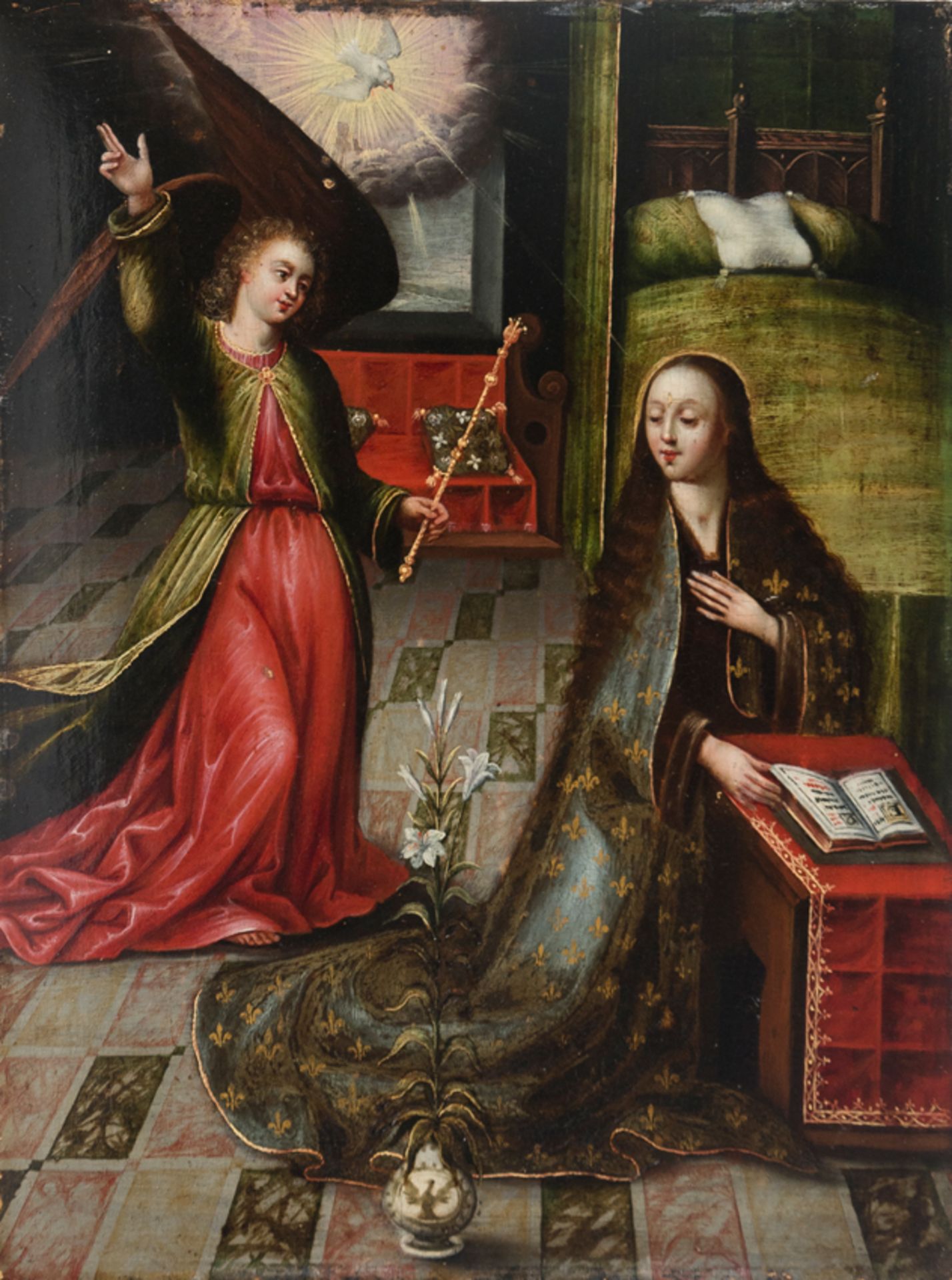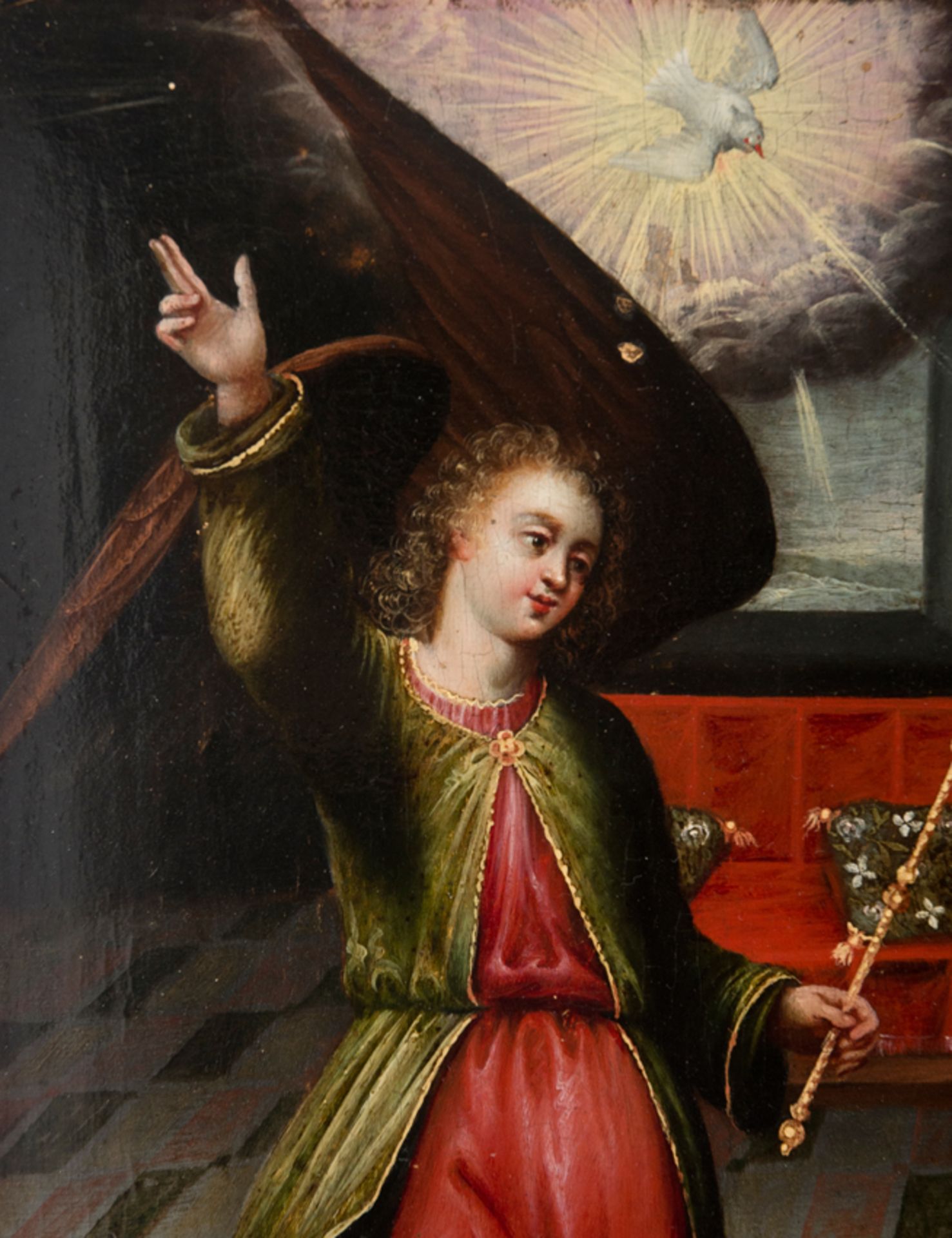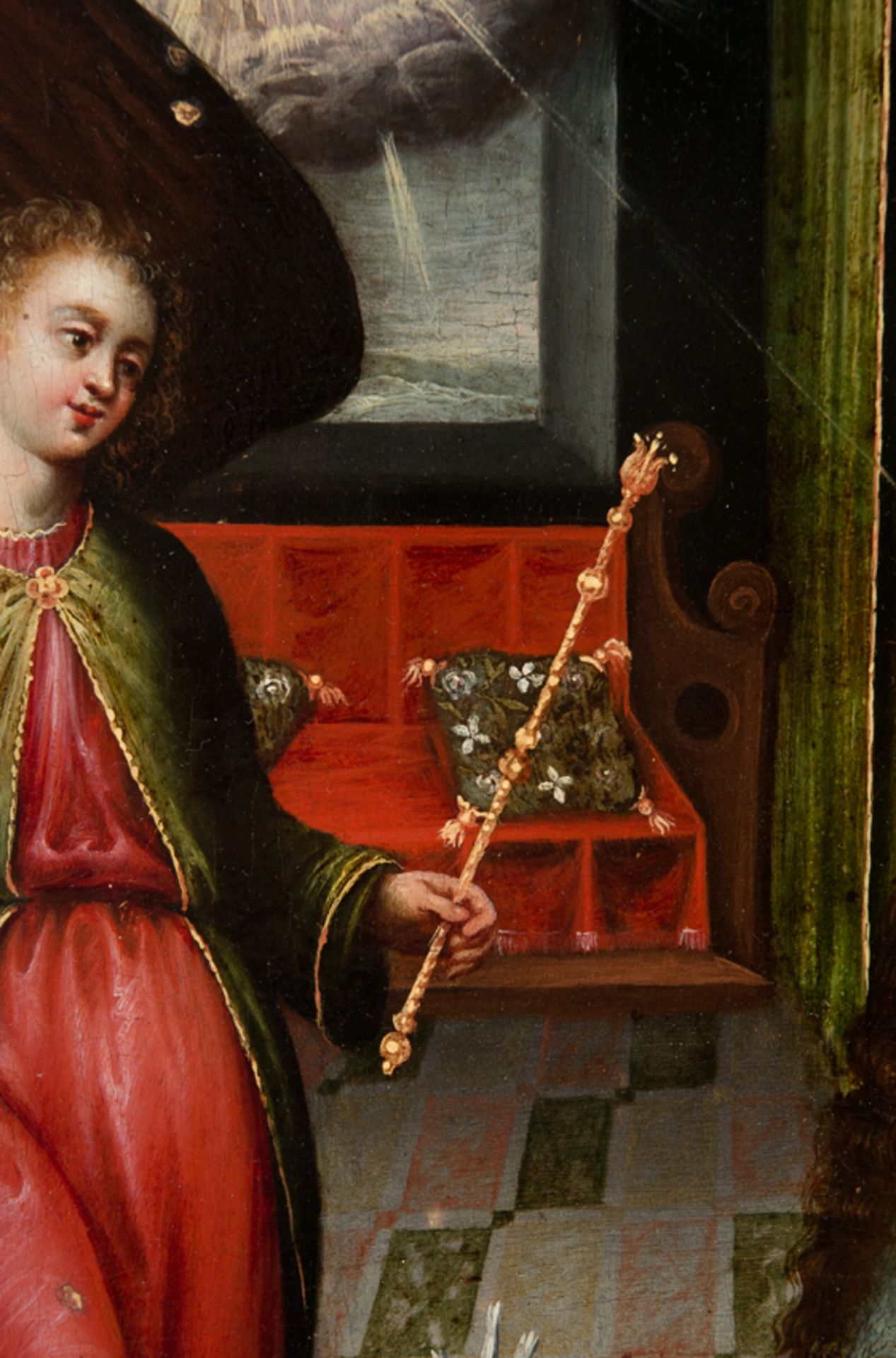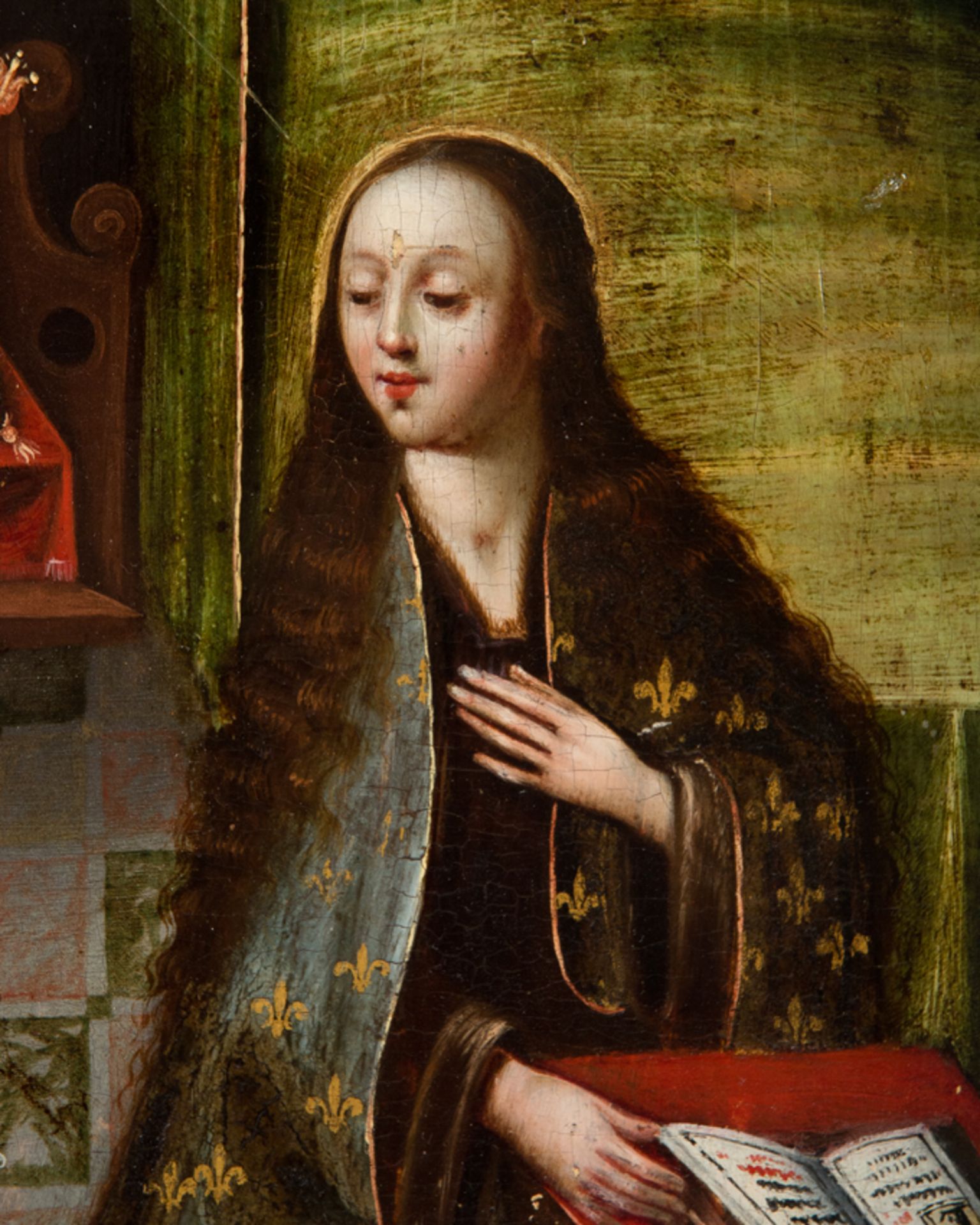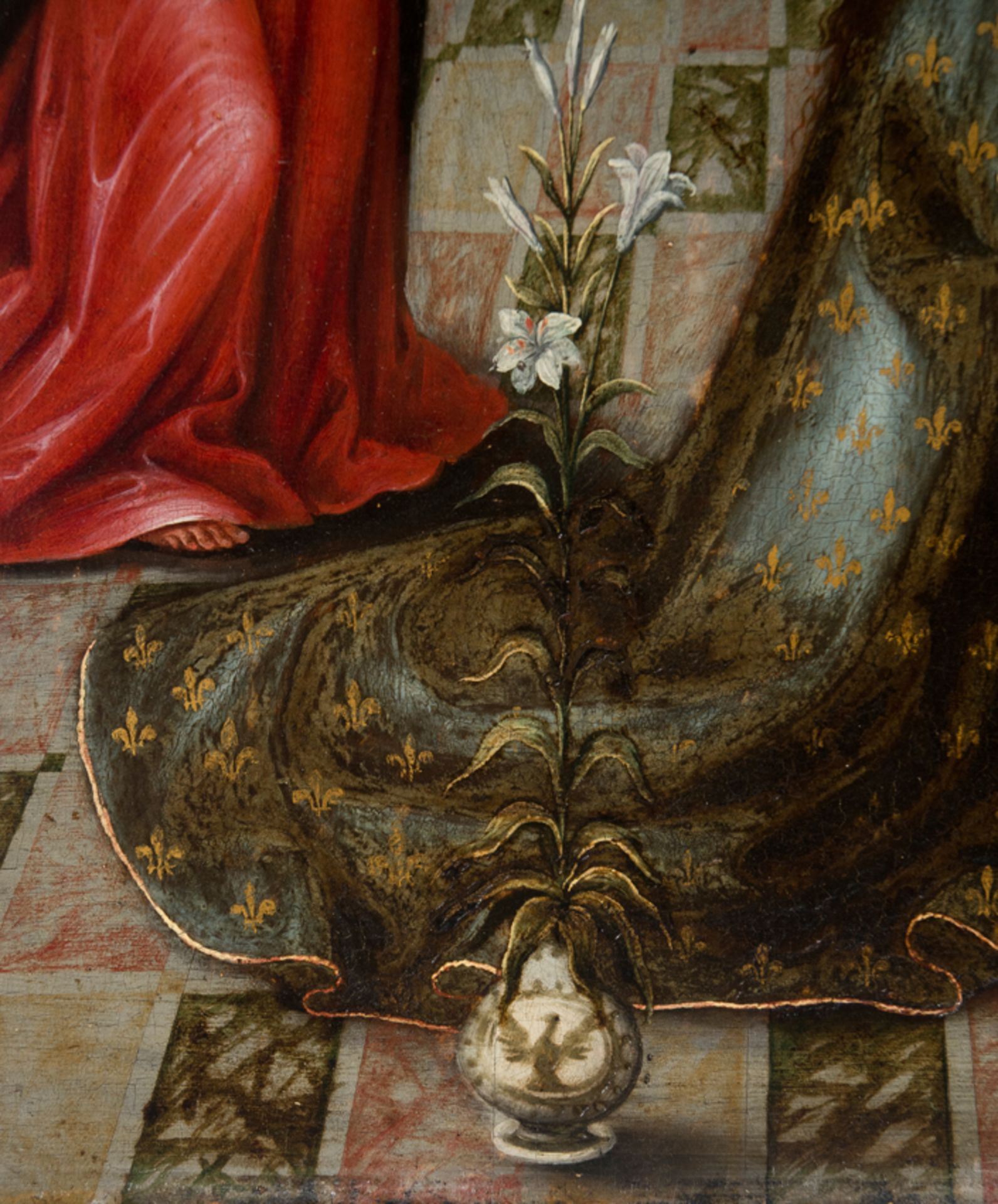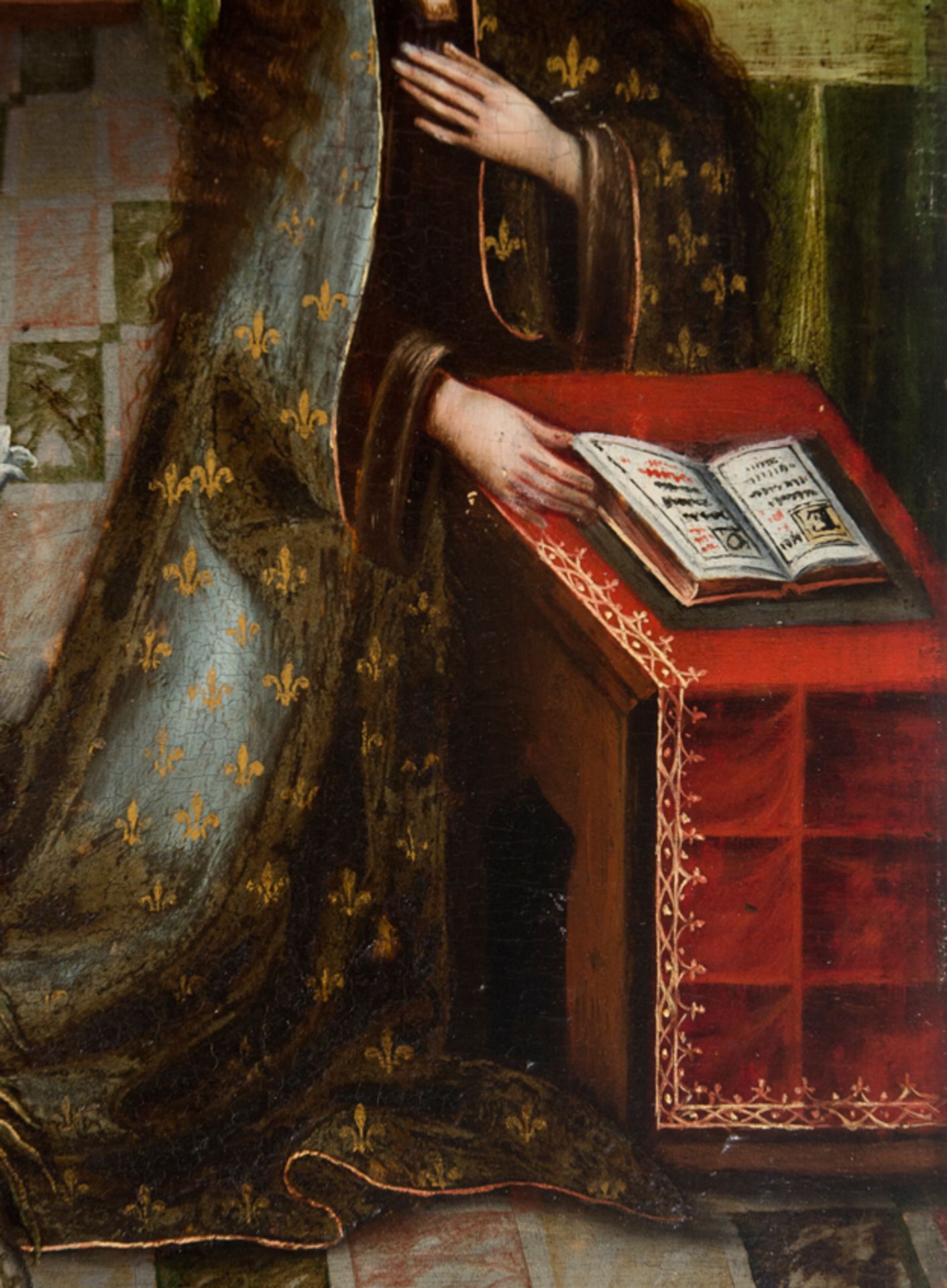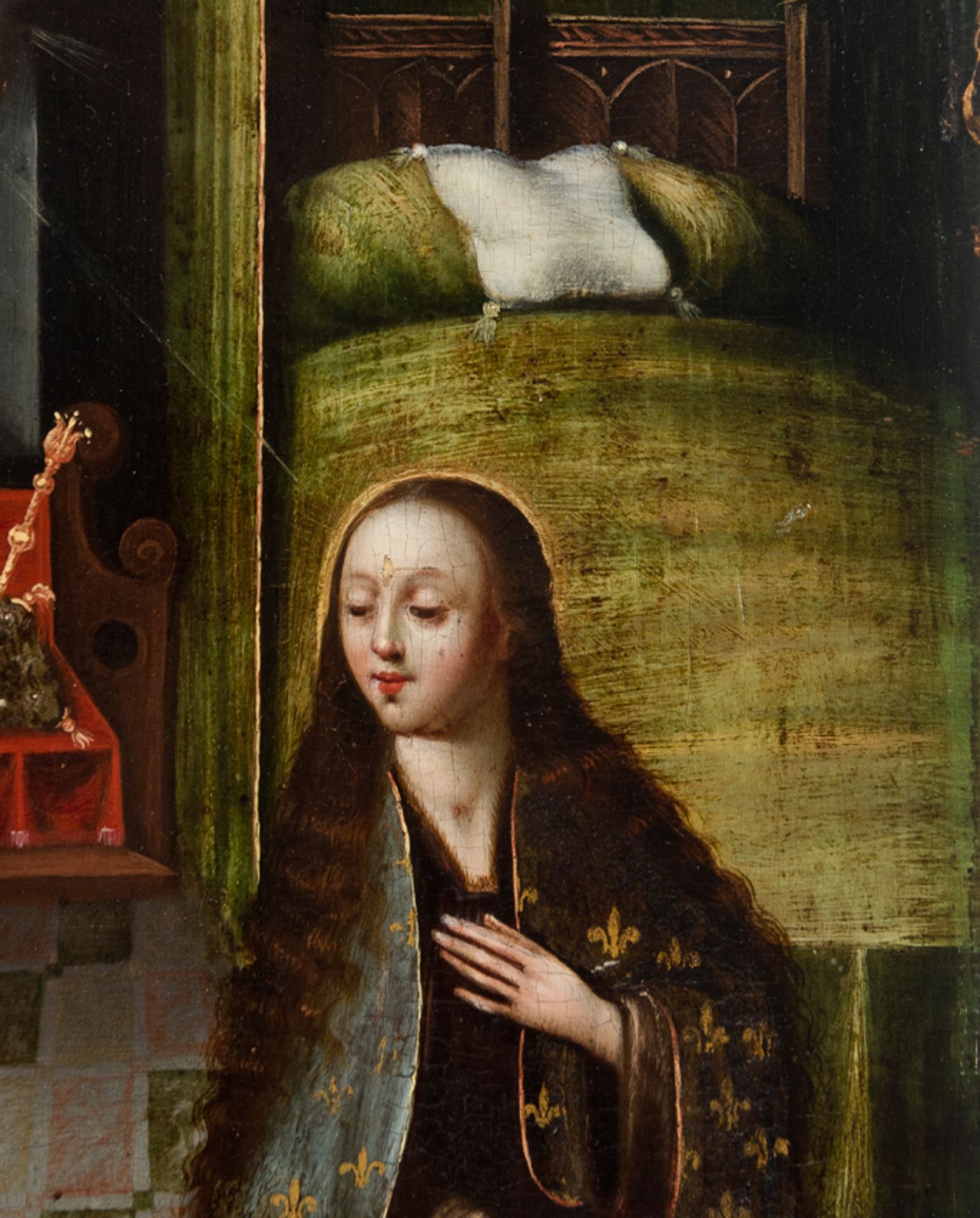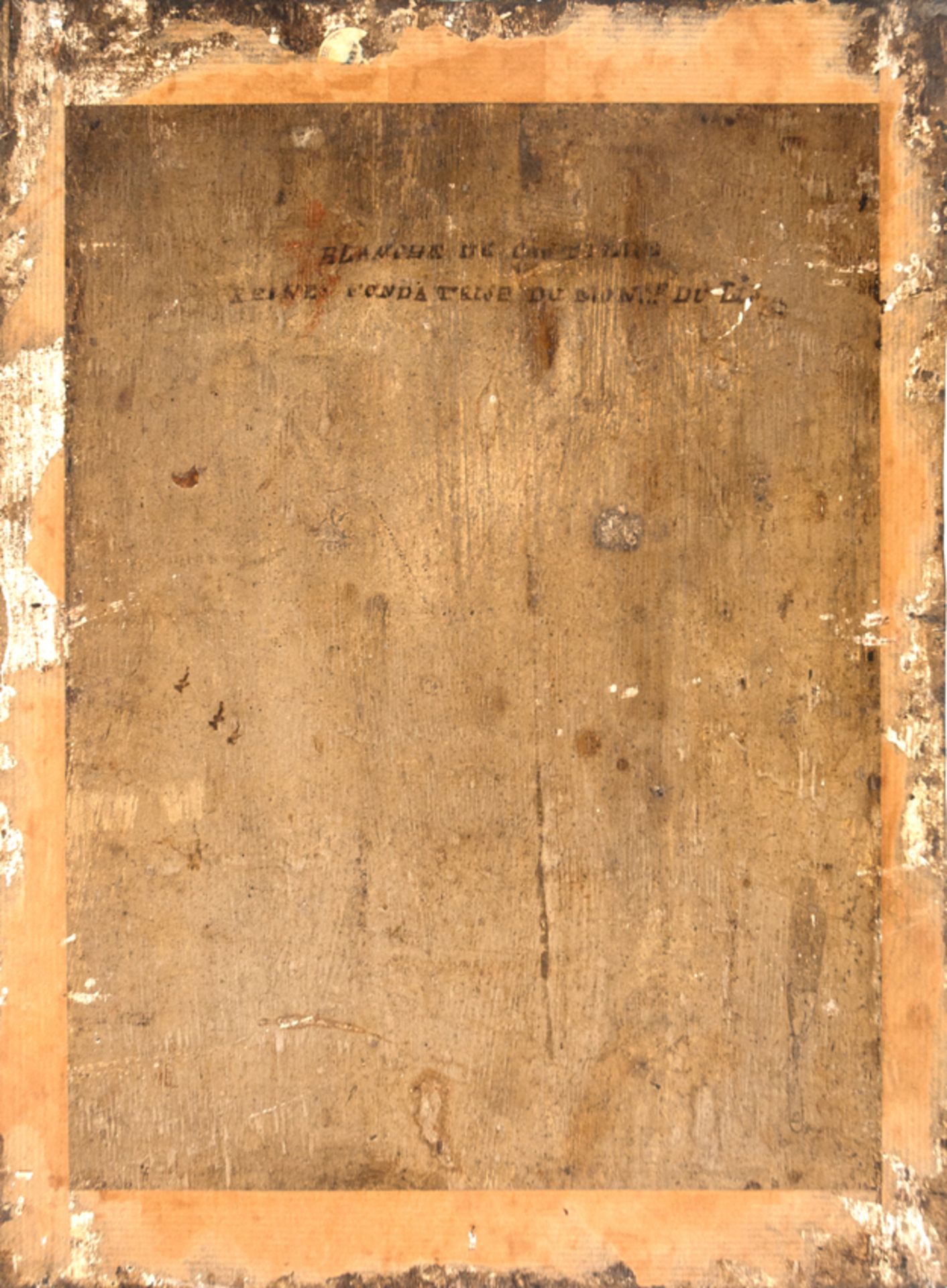12
Possibly Spanish School. First half of the 16th century.
Possibly Spanish School. First half of the 16th century.
"The Annunciation"
Oil on panel 41 x 31 cm.
This very valuable and unusual panel represents the episode of the Annunciation in the luxurious private chambers of the Virgin. She appears kneeling in front of a table decorated with a red cloth with gold trim, on which rests the book she was reading until the sudden appearance of God's envoy. The arrival of the archangel has caused the Virgin to put down her book and turn her face to observe the unexpected visitor. Saint Gabriel, as usual, arrives from the left side of the scene. He is standing, in the act of approaching the Virgin, which is why his right leg can be seen pushing forward under his tunic, with his wings unfolded in different directions. In his left hand he grasps a golden sceptre topped with a kind of fleur-de-lys: it is the messenger's staff, which, according to Réau, is a transposition of the one carried by the god Mercury, "messenger of Jupiter, from whom the Announcing angel takes his ancient herald's wand, the staff of command entrusted by the celestial emperor to his extraordinary and plenipotentiary ambassador”. He extends his right arm pointing with his index and middle fingers towards the sky to emphasise the fact that the message he brings comes directly from God. This “oratory gesture”, according to Réau, is taken directly from “the statues of the philosophers of antiquity, he extends his right hand towards the Virgin, raising his index finger to underline his words”.
Mary brings her left hand to her chest as a sign of compliance with the divine message, while with her right she still holds a page of the book she was reading. She wears a blue cloak, but in this case, it is a very dark blue and also decorated with small golden lily flowers. Her hair is thick and slightly wavy, falling in two large locks on both sides of her head. Her face, which is oval, with tiny facial features, a powerful chin and clear forehead, harks back to Flemish models.
The archangel wears a long reddish tunic that shows us only the toes of one of his feet, and over it a green overtunic open at the front and fastened at the neck by a brooch in the form of a golden quatrefoil.
Both characters have been conceived with well-defined volumes and with an interest in naturalness in both movements and expressions. The study of perspective is not completely successful, although the artist uses some devices to achieve it, such as the lines formed by the marble tiles of different colors (green, yellow and red) that pave the floor or the position of the bed. The painter has decided to capture the greatest possible number of details in the room, in the case of the bed with curtains or the seats decorated with red velvet and on which two cushions with floral motifs and gold fringes rest. In the foreground, there is a jug with lilies, an attribute that alludes to the purity of the Virgin Mary, and more especially to her virginity, which Saint Bernard refers to as the inviolable lilium castitatis.
In the upper part of the scene, entering through the only window of the room, which vanishes into a distant landscape that combines land and sea, the presence of the Holy Spirit is evident through the appearance of the symbolic dove and the sparkles that surround it, one of which falls on the face of the Virgin to emphasize the mystery of the Incarnation. It is a harmonious composition, very beautiful and with a rich range of colours.
The most mysterious detail of the table is found on its back, as there is an inscription in French: "Blanche de Castille Reine Fondatrice du Monastere du Lis". Blanca de Castilla was queen consort of France through her marriage to Louis VIII, and in turn was the mother of the holy king Louis IX. We do not know the reason for the appearance of this inscription, but it is striking that the Virgin's mantle appears completely upholstered with golden fleurs-de-lys, an emblem of the French monarchy and therefore of Blanca herself. Likewise, there is another detail which may have a symbolic meaning, which is the eagle type bird with outstretched wings painted on the front of the vase of lilies.
We would like to thank Javier Baladrón, doctor in History of Art, for cataloguing this piece.
Possibly Spanish School. First half of the 16th century.
"The Annunciation"
Oil on panel 41 x 31 cm.
This very valuable and unusual panel represents the episode of the Annunciation in the luxurious private chambers of the Virgin. She appears kneeling in front of a table decorated with a red cloth with gold trim, on which rests the book she was reading until the sudden appearance of God's envoy. The arrival of the archangel has caused the Virgin to put down her book and turn her face to observe the unexpected visitor. Saint Gabriel, as usual, arrives from the left side of the scene. He is standing, in the act of approaching the Virgin, which is why his right leg can be seen pushing forward under his tunic, with his wings unfolded in different directions. In his left hand he grasps a golden sceptre topped with a kind of fleur-de-lys: it is the messenger's staff, which, according to Réau, is a transposition of the one carried by the god Mercury, "messenger of Jupiter, from whom the Announcing angel takes his ancient herald's wand, the staff of command entrusted by the celestial emperor to his extraordinary and plenipotentiary ambassador”. He extends his right arm pointing with his index and middle fingers towards the sky to emphasise the fact that the message he brings comes directly from God. This “oratory gesture”, according to Réau, is taken directly from “the statues of the philosophers of antiquity, he extends his right hand towards the Virgin, raising his index finger to underline his words”.
Mary brings her left hand to her chest as a sign of compliance with the divine message, while with her right she still holds a page of the book she was reading. She wears a blue cloak, but in this case, it is a very dark blue and also decorated with small golden lily flowers. Her hair is thick and slightly wavy, falling in two large locks on both sides of her head. Her face, which is oval, with tiny facial features, a powerful chin and clear forehead, harks back to Flemish models.
The archangel wears a long reddish tunic that shows us only the toes of one of his feet, and over it a green overtunic open at the front and fastened at the neck by a brooch in the form of a golden quatrefoil.
Both characters have been conceived with well-defined volumes and with an interest in naturalness in both movements and expressions. The study of perspective is not completely successful, although the artist uses some devices to achieve it, such as the lines formed by the marble tiles of different colors (green, yellow and red) that pave the floor or the position of the bed. The painter has decided to capture the greatest possible number of details in the room, in the case of the bed with curtains or the seats decorated with red velvet and on which two cushions with floral motifs and gold fringes rest. In the foreground, there is a jug with lilies, an attribute that alludes to the purity of the Virgin Mary, and more especially to her virginity, which Saint Bernard refers to as the inviolable lilium castitatis.
In the upper part of the scene, entering through the only window of the room, which vanishes into a distant landscape that combines land and sea, the presence of the Holy Spirit is evident through the appearance of the symbolic dove and the sparkles that surround it, one of which falls on the face of the Virgin to emphasize the mystery of the Incarnation. It is a harmonious composition, very beautiful and with a rich range of colours.
The most mysterious detail of the table is found on its back, as there is an inscription in French: "Blanche de Castille Reine Fondatrice du Monastere du Lis". Blanca de Castilla was queen consort of France through her marriage to Louis VIII, and in turn was the mother of the holy king Louis IX. We do not know the reason for the appearance of this inscription, but it is striking that the Virgin's mantle appears completely upholstered with golden fleurs-de-lys, an emblem of the French monarchy and therefore of Blanca herself. Likewise, there is another detail which may have a symbolic meaning, which is the eagle type bird with outstretched wings painted on the front of the vase of lilies.
We would like to thank Javier Baladrón, doctor in History of Art, for cataloguing this piece.
"On Prophets, Saints and Princesses"
Sale Date(s)
Venue Address
General delivery information available from the auctioneer
The purchase price includes the delivery of the lots in the venue of the auction. Transporting to other destinations is at the own risk of the client. The customer must contact "LST", to give the corresponding instructions for such transporting. "LST" is not responsible for the packaging or any accident incurred during transportation.
Important Information
Aufgeld / Premium: 22 %
Live: 3 %
jeweils plus 21 % USt. / each plus 21 % VAT
Terms & Conditions
CONDITIONS OF THE AUCTION:
I. REGISTRATION. To bid in the room customers must register at the beginning, filling out a form and picking a number that will identify them during the auction. Customers may be required to register in bank references or other guarantee system and if they do not prove the solvency "LST" will not accept bids and award the auction.
II. WRITTEN BIDS. "LST" will accept written bids, which will be formalized in the form provided by the room until the day before the auction. In such auctions, the room will bid in name of the client until the maximum stated in the offer and always at the lowest possible price. If there are two or more bids for the same amount, the one placed first will have the priority. Written bids received in advance, will have priority on the day of the auction.
III. TELEPHONE BIDS. "LST" will allow telephone bids, if interested people contact "LST" days before the auction providing personal data, ID card and the phone number which will be used by the staff of "LST" to call at the time of the auction. The buyer, within all the legal rights is making an offer for the asking price, when applies for telephone bid. "LST" will not take responsibility for any technical defects beyond its control, which may prevent to contact successfully the bidder during the auction.
IV. AUCTIONEER. The auction will be conducted by an auctioneer, director of the auction will be judge and arbitrator of it with full authority in its development, will award the lots to the highest bidder and is able to settle any controversy concerning lots sale, reject bids, divide lots or group them and remover objects from the room. Will be able to, if it is deemed suitable, not accept bids on the auction. His decision will be unappealable.
V. SALE OF LOTS. The lots are awarded to the highest bidder. Once the auctioneer blows the hammer, the buyer becomes responsible of the lot purchased, exempting "LST" of liability to for any damage and / or accidents that may occur. No refunds of lots.
VI. STARTING PRICE. The amount shown in the catalogue as the starting price for each lot will be, as a rule, the minimum selling price, except for exceptional cases where a reservation may be agreed upon with the seller or it set discretionary by the room.
VII. SCALE OF BIDS. The bids are set according to the following scale:
From 50.-€ to 200.-€…………………………………………..at 10.-€
From 200.-€ to 500.-€…………………………………… …25 in 25.-€
From 500.-€ to 1.000.-€………………………………..…..….50 in 50.-€
From 1.000.-€ to 2.000.-€………………………………..…100 in 100.-€
From 2.000.-€ to 5.000.-€……………………………….….250 in 250.-€
From 5.000.-€ to 10.000.-€…………………………………500 in 500.-€
From 10.000.-€ to 20.000.-€……………………………1.000 in 1.000.-€
From 20.000.-€ to 50.000.-€……………………………2.500 in 2.500.-€
From 50.000.-€ to 100.000.-€…………………………..5.000 in 5.000.-€
From 100.000.-€ to 100.000.-€………………………10.000 in 10.000.-€
From 200.000.-€ to 200.000.-€………………………25.000 in 25.000.-€
From 500.000.-€ to 500.000.-€………………………50.000 in 50.000.-€
VIII. RIGHT OF ADMISION. "LST" reserves the right to admission to the auction room and to reject, at its judgment, any purchase order, from clients whose solvency is not duly proved as well as not to sale auctions.
IX. SALE PRICES. The successful bidder of one or more lots must pay "LST" the final sale price achieves at auction, plus the 22 % plus 21% VAT on the commission, at total 26,62 % on Hammer Price.
X. CATALOG DATA. The catalogue data are obtained in order to careful research and advice, however, any responsibility is afforded about its accuracy. The lots will be auctioned in the state in which they are, not accepting any claims in restorations, breakage, damage, imperfections and, even description or numbering mistakes in the catalogue, in case of it, being the burden of the buyers to make sure before the auction that the description matches with their personal opinion about respective lot. The exhibition of the lots is intended to allow a perfect review and study of them.
XI. PAYMENT AND REMOVAL OF LOTS. Payment and removal of the lots will be held no later than five days following the auction. After this period expire without having the buyer removed the lot or lots purchases, it will accrue an expense of custody of 6 euros per day on each lot.
15 days after the auction without having the buyer paid and removes the sold lots, "LST" will inform the seller and there will begin judicial proceeding in order to obtain payment. The delay in payment by the purchaser of his/her sold lots will carry an interest increase at a rate of 1,5% per month.
XII. DELIVERY OF LOTS. The purchase price includes the delivery of the lots in the venue of the auction. Transporting to other destinations is at the own risk of the client. The customer must contact "LST", to give the corresponding instructions for such transporting. "LST" is not responsible for the packaging or any accident incurred during transportation.
XIII. RIGHT OF FIRT REFUSAL AND REPURCHASE. "LST" in order to article 38 of "Ley 16/1985 de 25 Junio del Patrimonio Histórico Español" (BOE. 155 June 29, 1985), will notify in advance to the Ministry of Culture, the content of their catalogues. Concerning the lots subject to the legislation referred to in the preceding paragraph, the Administration may exercise the rights of first refusal and repurchase according to the law. "LST" will watch over the protection of Artistic, Historical and Bibliographical Heritage of Spain. For customers out of European Community, a tax for export is required by the Administration.
XIV. VALUE ADDED TAX (I.V.A). This tax will be accrued on commissions of "LST" for buyers, using the rates prevailing on the date of the auction.
XV. DATA PROTECTION. In order to the "Ley 15/1999 de 13 de Diciembre, de Protección de Datos de Carácter Personal", the client authorize "LST", the inclusion of their data in a customer file, and for the promotion by "LST" of the objects at all times the rights of access, rectification or deletion of personal data by sending the appropriate request to the following address: LA SUITE SUBASTAS, C/ Conde Salvatierra, 8, 08006. Barcelona.
XVI. EXPRESS LEGAL JURISDICTION. These Conditions are governed by and interpreted in accordance with the rules of Spanish law. The mere act of participating in the auction as seller, buyer or bidder, implies acceptance of these Terms and Conditions.
Sales operations are understood to be held at the registered office of "LST", C/ Conde de Salvatierra, 8, 08006. Any dispute shall be taken to the competent courts of Barcelona, expressly waiving any other jurisdiction, in accordance with Article 55 of the "Ley de Enjuiciamiento Civil".


















